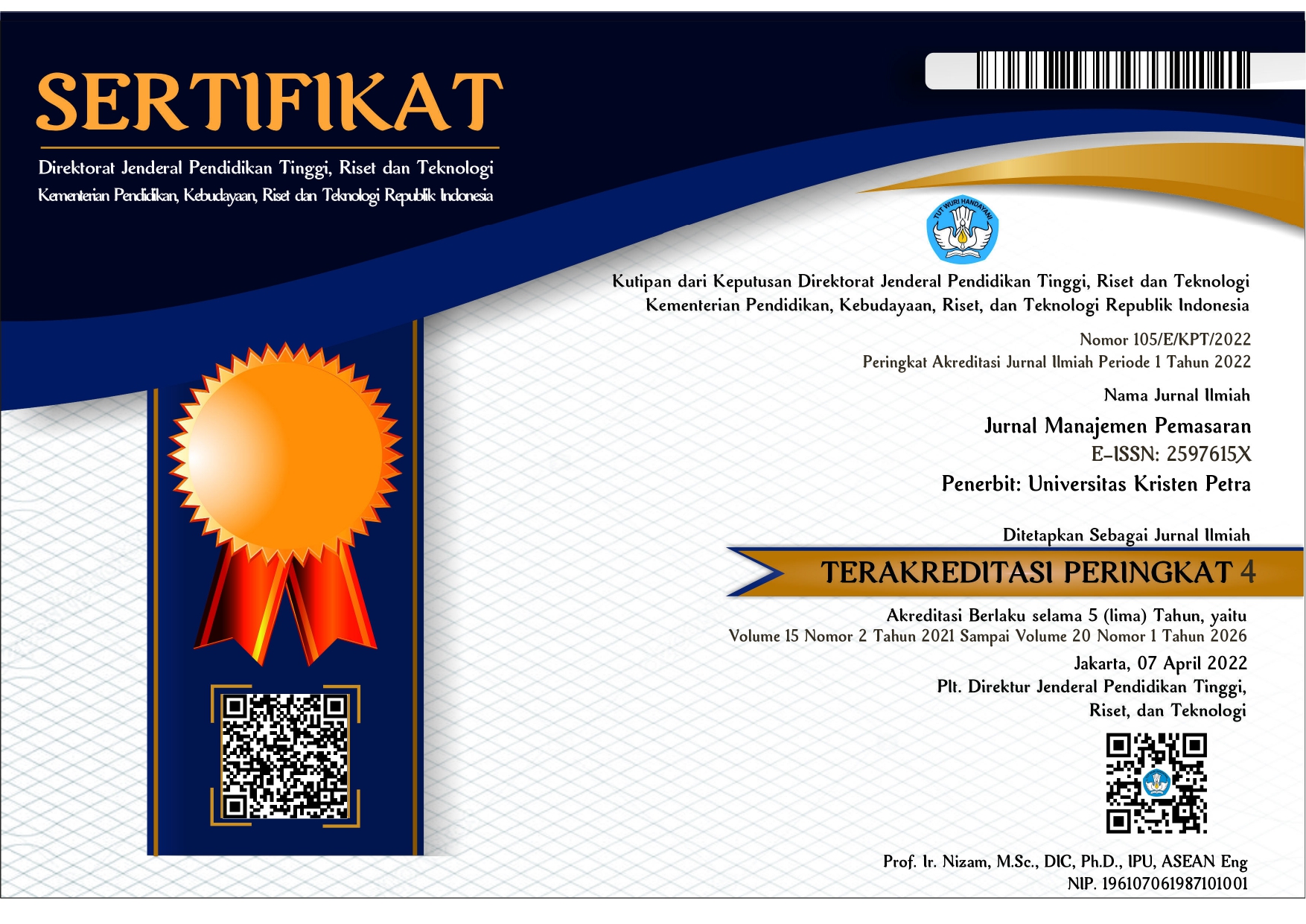THE RELATIONSHIP BETWEEN RISK AVERSION AND BRAND LOYALTY IN MEN’S CARE PRODUCTS
DOI:
https://doi.org/10.9744/pemasaran.17.2.73-80Keywords:
brand affect, brand loyalty, brand trust, men's care, risk aversionAbstract
Developing e-commerce platforms in Indonesia has also contributed to the growth of the cosmetic and personal care product sector. Currently, cosmetic products are no longer only intended for women but also men. Thus, creating opportunities and a conducive environment for the emergence of new companies. With the increasing number of companies in the men's cosmetic industry today, building brand loyalty is one of the biggest challenges companies will face. This study aims to explore the relationship between risk aversion and brand loyalty and test whether this relationship is mediated by brand trust and brand affect in men's purchase of cosmetic and body care products. The sample selection was carried out using a purposive sampling method with 130 respondents with the criteria of being male students in Surabaya. Data analysis using SEM-PLS variant-based structural equation method. The results showed that risk aversion is statistically significant in influencing brand trust, brand affect, and brand loyalty. Brand trust and brand affect are also statistically significant in influencing brand loyalty. By analysing brand loyalty and the variables that influence it, cosmetic and men's body care product companies can understand how to develop brand loyalty, especially by paying attention to risk aversion, brand trust, brand affect, and brand loyalty.
References
Agusty, L. E., & Muttaqin, A. A. (2022). Analisis pengaruh label halal, kesadaran halal, dan persepsi atas produk halal dalam pembelian kosmetik halal. Islamic Economics and Finance in Focus, 1(4), 373-387. https://doi.org/10.21776/ieff.2022. 01.4.08
Akoglu, H. E., & Özbek, O. (2022). The effect of brand experiences on brand loyalty through perceived quality and brand trust: A study on sports consumers. Asia Pacific Journal of Marketing and Logistics, 34(10), 2130 – 22148. https://doi.org/10.1108/APJML-05-2021-0333
Almodarresi, S. M. A., & Rasty, F. (2019). The moderating effect of emotion regulation on the relationship between risk aversion and brand sensitivity. Journal of Product and Brand Manage¬ment, 28(1), 95–103. https://doi.org/10.1108/JPBM-09-2017-1581
Aren, S., & Hamamci, H. N. (2020). Relationship between risk aversion, risky investment intention, investment choices: Impact of personality traits and emotion. Kybernetes, 49(11), 2651–2682. https://doi.org/10.1108/K-07-2019-0455
Ashaduzzaman, M., Jebarajakirthy, C., Weaven, S. K., Maseeh, H. I., Das, M., & Pentecost, R. (2022). Predicting collaborative consumption behaviour: a meta-analytic path analysis on the theory of planned behaviour. In European Journal of Marketing (Vol. 56, Issue 4, pp. 968–1013). Emerald Group Holdings Ltd. https://doi.org/10.1108/EJM-07-2020-0563
Chubukova, O., Kostynets, I., Ponomarenko, I., Rallie, N., & Zymbalevska, Y. (2019). Factor model of social media marketing effect on brand loyalty. SHS Web of Conferences, 65, 04011. https://doi.org/10.1051/shsconf/20196504011
Gültekin, B., & Kiliç, S. I. (2022). Repurchasing an environmental related crisis experienced auto-mobile brand: An examination in the context of environmental consciousness, brand trust, brand affect, and resistance to negative information. Sosyoekonomi, 30(51), 241–260. https://doi.org/10.17233/sosyoekonomi.2022.01.12
Hair, J. F., Black, W. C., Babin, B. J., & Anderson, R. E. (2019). Multivariate data analysis eight edition.
Haq, M. I. U., Alvi, A. K., Somroo, M. A., Akhtar, N., & Ahmed, A. (2022). Relationship of brand credibility and brand loyalty: the mediating effects of attitude toward brand. Journal of Economic and Administrative Sciences. https://doi.org/10.1108/jeas-08-2021-0142
Hardani, H., & Fardani, R. (2020). Buku metode pene-litian kualitatif & kuantitatif. Retrieved from https://www.researchgate.net/publication/340021548
Huaman-Ramirez, R., Albert, N., & Merunka, D. (2019). Are global brands trustworthy?: The role of brand affect, brand innovativeness, and consumer ethnocentrism. European Business Review, 31(6), 926–946. https://doi.org/10.1108/EBR-11-2017-0202
Matzler, K., Grabner-Kräuter, S., & Bidmon, S. (2008). Risk aversion and brand loyalty: The mediating role of brand trust and brand affect. Journal of Product and Brand Management, 17(3), 154–162. https://doi.org/10.1108/10610420810875070
Mishra, M. K., Kesharwani, A., & Das, D. (2016). The relationship between risk aversion, brand trust, brand affect and loyalty: Evidence from the FMCG industry. Journal of Indian Business Research, 8(2). https://doi.org/10.1108/JIBR-04-2015-0045
Nguyen, D. T., Le, D. H. A., Truong, L. G., Truong, N. G., & Vu, V. V. (2022). The effect of Generation Z’s perceptions of brand activism on brand loyalty: evidence from Vietnam. Asia Pacific Journal of Marketing and Logistics. https://doi.org/10.1108/APJML-02-2022-0165
Raju, P. S. (1980). Optimum stimulation level: its relationship to personality, demographics, and exploratory behavior.
Rostami, M., Pour, H. F., & Saboonchi, R. (2019). The causal model of brand personality, risk aversion and customer loyalty. Journal of System Management, 3.
Samarah, T., Bayram, P., Aljuhmani, H. Y., & Elrehail, H. (2022). The role of brand interactivity and involvement in driving social media consumer brand engagement and brand loyalty: The mediating effect of brand trust. Journal of Research in Interactive Marketing, 16(4), 648–664. https://doi.org/10.1108/JRIM-03-2021-0072
Sjabadhyni, B., Mustika, M. D., Pane, K. A., Kaur, D., & Eryandra, A. (2019). Does experience lead people to buy? The formation of brand loyalty using the theory of love on older consumers. Humaniora, 10(2), 153. https://doi.org/10.21512/humaniora.v10i2.5576
Downloads
Published
How to Cite
Issue
Section
License
Copyright (c) 2023 Dwi Anna Kristanti

This work is licensed under a Creative Commons Attribution 4.0 International License.

















